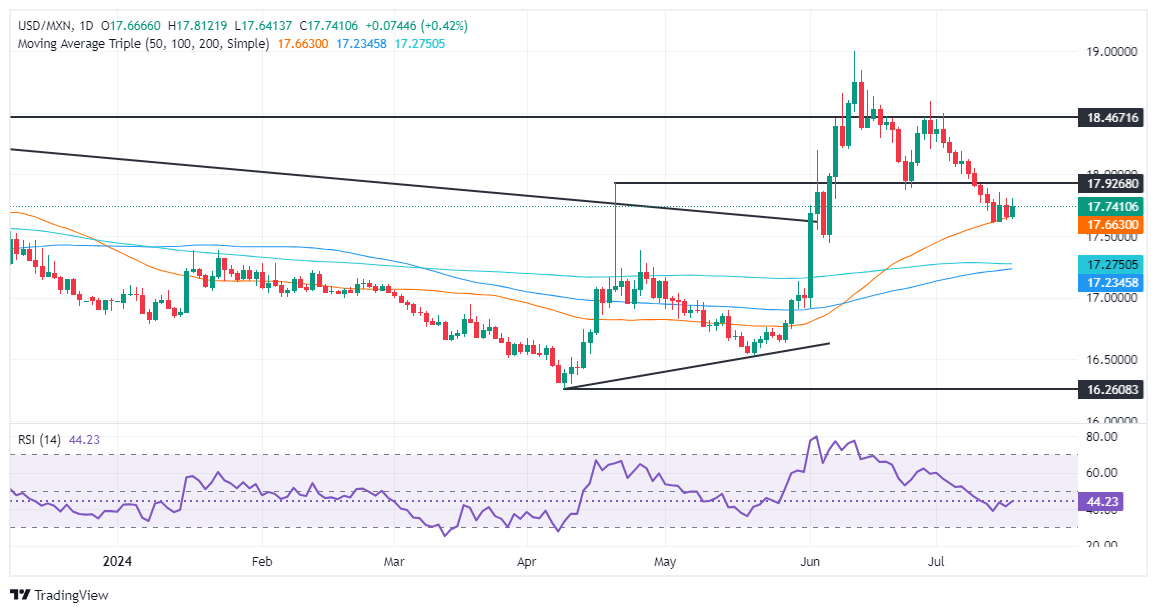- The Mexican Peso lost 0.20% as the USD/MXN rebounded from a daily low of 17.63.
- IMF cuts Mexico’s GDP forecast for 2024 from 2.4% to 2.2% amid economic slowdown.
- Trump’s interview increases market volatility; Fed officials hint at possible rate cuts.
The Mexican Peso stumbled and lost around 0.20% on Wednesday as risk appetite deteriorated. Former US President and Republican candidate Donald Trump’s interview with Bloomberg spooked investors, and Wall Street stock indices plunged. Thus, the USD/MXN is trading at 17.70 after bouncing from daily lows of 17.63.
The economic agenda in Mexico is absent, although the deputy governor of the Bank of Mexico, Omar Mejía Castelazo, crossed the lines, saying that although Banxico cut rates, this does not mean the beginning of a cycle of interest rate cuts.
Meanwhile, the International Monetary Fund (IMF) adjusted Mexico’s Gross Domestic Product (GDP) expectations for 2024 from 2.4% to 2.2%. The revision shows Mexico’s ongoing economic slowdown driven by the manufacturing contraction, observed in the first quarter of 2024, attributed to a slowdown experienced in the US economy.
IMF Deputy Director of Research Petya Koeva Brooks said, “We have revised our forecast for this year slightly downward, which compares with strong growth last year when there was a lot of nonresident investment in construction, as well as a significant expansion in U.S.-led manufacturing activity.”
Bloomberg also published an interview with Donald Trump. He said he favors tax cuts, lower interest rates, and tariffs, including a 60% to 100% increase on goods from China and a 10% increase in the general rate on other countries.
Trump added that he would allow current Fed Chairman Jerome Powell to finish his term, but warned that the Fed would not cut interest rates before the election.
Lately, Federal Reserve officials have crossed lines. Richmond Fed President Thomas Barkin said inflation has declined in the past quarter, asserting that current policy is restrictive. However, he is open to the idea that policy is “not as restrictive as previously thought.”
His colleague, Fed Governor Christopher Waller, commented that the time to cut the policy rate is approaching, adding that the most likely direction for the federal funds rate is downwards.
Daily Market Drivers Roundup: Mexican Peso Weakens on Trump Comments
- Mexico’s economic agenda will be absent this week, resuming on July 22, when the National Statistics Agency (INEGI) reveals growth figures for May. However, policymakers at the Bank of Mexico (Banxico) and political developments could stir things up.
- Mexico’s June inflation figures came in higher than expected due to a rise in food prices, when most economists expect Banxico to resume cutting interest rates.
- The U.S. economic calendar featured June building permits, which rose from 1.3999 million to 1.446 million, an increase of 3.4%. Other housing data showed housing starts for the same period expanded 3% from 1.314 million to 1.353 million.
- U.S. industrial production in June slowed to 0.6% on a monthly basis from 0.9% in May, but beat estimates for a 0.3% increase.
- CME FedWatch tools show that the odds of a quarter-point cut in the federal funds rate in September are 100%, limiting the dollar’s advance.
- June consumer inflation figures came in lower than expected in the United States, raising the odds that the Federal Reserve will cut borrowing costs in 2024 by at least 54 basis points, according to the December 2024 federal funds rate futures contract.
Technical Analysis: Mexican Peso Stumbles as USD/MXN Rises Above 17.70
The USD/MXN bottomed around the 50-day simple moving average (SMA) after the pair fell more than 2.50% as the Mexican currency appreciated. However, buyers have stepped in, forming a bottom around 17.58-17.60.
Momentum suggests that sellers are in charge, as shown by the RSI below the neutral line of 50. Buyers appear to be gaining some strength, as the RSI has surpassed its previous peak.
If USD/MXN extends its gains above the July 15 high of 17.85, that would exacerbate a rally towards the psychological figure of 18.00. A break of the latter will expose the July 5 high of 18.19, followed by the June 28 high of 18.59, allowing buyers to target the yearly high of 18.99.
On further weakness, if USD/MXN breaks above the 50-day SMA at 17.63, that would pave the way for a challenge to the Dec. 5 high at 17.56, followed by the 200-day SMA at 17.27. Further losses would test the 100-day SMA at 17.21.
The feeling of risk
What do the terms “risk-on” and “risk-off” mean when referring to sentiment in financial markets?
In the world of financial jargon, the two terms “risk-on” and “risk-off” refer to the level of risk that investors are willing to bear over the reference period. In a “risk-on” market, investors are optimistic about the future and are more willing to buy risky assets. In a “risk-off” market, investors start to “play it safe” because they are worried about the future and therefore buy less risky assets that are more certain to provide a return, even if relatively modest.
Typically, during periods of “risk appetite”, stock markets rise, and most commodities – except gold – also appreciate as they benefit from positive growth prospects. Currencies of countries that are major commodity exporters strengthen due to increased demand, and cryptocurrencies rise. In a “risk-off” market, bonds rise – especially major government bonds –, gold shines, and safe haven currencies such as the Japanese Yen, Swiss Franc and US Dollar benefit.
The Australian Dollar (AUD), Canadian Dollar (CAD), New Zealand Dollar (NZD) and minor currencies such as the Ruble (RUB) and South African Rand (ZAR) tend to rise in markets where there is “risk appetite”. This is because the economies of these currencies are highly dependent on commodity exports for growth, and these tend to rise in price during periods of “risk appetite”. This is because investors anticipate higher demand for commodities in the future due to increased economic activity.
The major currencies that tend to rise during periods of “risk aversion” are the US Dollar (USD), the Japanese Yen (JPY) and the Swiss Franc (CHF). The Dollar, because it is the world’s reserve currency and because in times of crisis investors buy US government debt, which is considered safe because the world’s largest economy is unlikely to default. The Yen, because of increased demand for Japanese government bonds, since a large proportion are held by domestic investors who are unlikely to part with them, even in a crisis. The Swiss Franc, because strict Swiss banking legislation offers investors greater capital protection.
Source: Fx Street
I am Joshua Winder, a senior-level journalist and editor at World Stock Market. I specialize in covering news related to the stock market and economic trends. With more than 8 years of experience in this field, I have become an expert in financial reporting.








